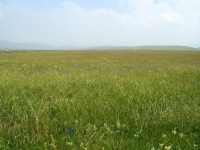This post is the "Part 2" edition of Jeff's blog post about Xeric Prairies that first appeared last Thursday, November 21st. To view the first part of this blog, visit here.
"The disappearance of a major natural unit of vegetation from the face of the earth is an event worthy of causing pause and consideration by any nation. Yet so gradually has the prairie been conquered by the breaking plow, the tractor, and the overcrowded herds of man...that scant attention has been given to the significance of this endless grassland or the course of its destruction. Civilized man is destroying a masterpiece of nature without recording for posterity that which he has destroyed." – John Ernest Weaver
When the European settlers came to North America, they were unfamiliar with the landscape they encountered. Because of that, they did most of their settling and farming in wooded areas. Additionally, the tools they brought with them were not adequate to break up the harder prairie soil. But from 1830 to 1900, everything changed with the addition of John Deere's steal moldboard blow. During that time frame, 240 million acres of prairie were converted into farmland. In Wisconsin, prairies were historically found southwest of the tension zone that runs from Polk County to Sheboygan County. At the time of settlement, there was roughly 2.1 million acres of prairie (6% of the total land surface of Wisconsin). Today, less than 200,000 acres of prairies are left intact; a majority of this is segmented and found only in remnant cemeteries, restoration projects, and areas not accessible to farming equipment.
Prairie reduction isn't due to agriculture alone - vast population growth is also responsible. In the same time frame of 1830-1900, the population in Wisconsin grew from 3,245 to 2.1 million people. Today, the amount of agricultural land in Wisconsin has stayed about the same, but the population has grown to about 5.3 million people. With all this expansion, prairies were replaced with housing developments.
Where to go from here?
This topic is too large for me to talk about everything regarding prairies and Xeric prairies, but I hope this blog post sparked some interest. If you're interested, come and volunteer at any of the Land Stewardship volunteer times at Riverside Park, Washington Park, or Menomonee Valley. We are always more than happy to talk, and teach about this native habitat. You will also help us in our work of restoring over 100 acres of prairies and other native plant communities! Also, be sure to check out my first blog post on Xeric prairies here.
There are also many resources and books out there that will teach you about prairies. Some that I use here are "The Tallgrass Restoration Handbook for Prairies, Savannas, and Woodlands" by Packard & Mutel, "Vegetation of Wisconsin" by John T. Curtis, and "The Tallgrass Prairie Center Guide to Prairie Restoration in the Upper Midwest" By Smith, Williams, Houseal & Henderson.
I would like to leave you with one final quote.
"While I know the standard claim is that Yosemite, Niagara falls, the upper Yellowstone and the like, afford the greatest natural shows, I am not so sure but the Prairies and Plains, while less stunning at first sight, last longer, fill the aesthetic sense fuller, precede all the rest, and make North America's characteristic landscape." – Walt Whitman





